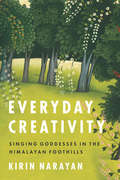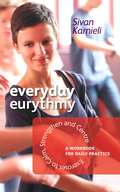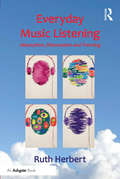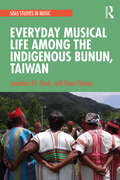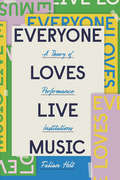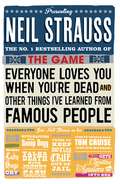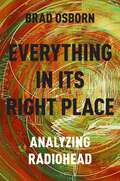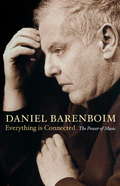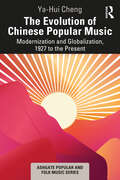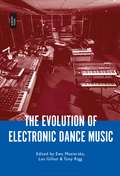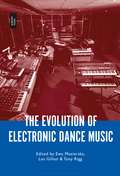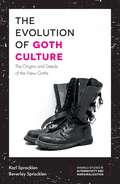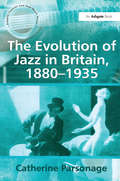- Table View
- List View
Everybody Loves Our Town: A History of Grunge
by Mark YarmGrunge, also known as the 'Seattle sound', is the sludgy fusion of punk rock and heavy metal that emerged from the Pacific Northwest in the early part of the 1980s. But it was the unexpected, seemingly overnight success of Nirvana's single 'Smells Like Teen Spirit,' in the fall of 1991, that made grunge a household word and launched an American music movement on par with punk and hip-hop.Twenty years later, Mark Yarm captures that era in the words of those at the forefront of the movement (and the music's lesser-known champions). Everybody Loves Our Town will tell the whole story: the founding of originators like Soundgarden and the Melvins, the early successes of Seattle's Sub Pop record label, the rise of powerhouses Nirvana and Pearl Jam, the insane media hype surrounding the grunge explosion, the suicide of Kurt Cobain, and finally, the genre's mid-to-late-'90s decline.
Everyday Creativity: Singing Goddesses in the Himalayan Foothills (Big Issues in Music)
by Kirin NarayanKirin Narayan’s imagination was captured the very first time that, as a girl visiting the Himalayas, she heard Kangra women join their voices together in song. Returning as an anthropologist, she became fascinated by how they spoke of singing as a form of enrichment, bringing feelings of accomplishment, companionship, happiness, and even good health—all benefits of the “everyday creativity” she explores in this book. Part ethnography, part musical discovery, part poetry, part memoir, and part unforgettable portraits of creative individuals, this unique work brings this remote region in North India alive in sight and sound while celebrating the incredible powers of music in our lives. With rare and captivating eloquence, Narayan portrays Kangra songs about difficulties on the lives of goddesses and female saints as a path to well-being. Like the intricate geometries of mandalu patterns drawn in courtyards or the subtle balance of flavors in a meal, well-crafted songs offer a variety of deeply meaningful benefits: as a way of making something of value, as a means of establishing a community of shared pleasure and skill, as a path through hardships and limitations, and as an arena of renewed possibility. Everyday Creativity makes big the small world of Kangra song and opens up new ways of thinking about what creativity is to us and why we are so compelled to engage it.
Everyday Creativity: Singing Goddesses in the Himalayan Foothills (Big Issues in Music)
by Kirin NarayanKirin Narayan’s imagination was captured the very first time that, as a girl visiting the Himalayas, she heard Kangra women join their voices together in song. Returning as an anthropologist, she became fascinated by how they spoke of singing as a form of enrichment, bringing feelings of accomplishment, companionship, happiness, and even good health—all benefits of the “everyday creativity” she explores in this book. Part ethnography, part musical discovery, part poetry, part memoir, and part unforgettable portraits of creative individuals, this unique work brings this remote region in North India alive in sight and sound while celebrating the incredible powers of music in our lives. With rare and captivating eloquence, Narayan portrays Kangra songs about difficulties on the lives of goddesses and female saints as a path to well-being. Like the intricate geometries of mandalu patterns drawn in courtyards or the subtle balance of flavors in a meal, well-crafted songs offer a variety of deeply meaningful benefits: as a way of making something of value, as a means of establishing a community of shared pleasure and skill, as a path through hardships and limitations, and as an arena of renewed possibility. Everyday Creativity makes big the small world of Kangra song and opens up new ways of thinking about what creativity is to us and why we are so compelled to engage it.
Everyday Creativity: Singing Goddesses in the Himalayan Foothills (Big Issues in Music)
by Kirin NarayanKirin Narayan’s imagination was captured the very first time that, as a girl visiting the Himalayas, she heard Kangra women join their voices together in song. Returning as an anthropologist, she became fascinated by how they spoke of singing as a form of enrichment, bringing feelings of accomplishment, companionship, happiness, and even good health—all benefits of the “everyday creativity” she explores in this book. Part ethnography, part musical discovery, part poetry, part memoir, and part unforgettable portraits of creative individuals, this unique work brings this remote region in North India alive in sight and sound while celebrating the incredible powers of music in our lives. With rare and captivating eloquence, Narayan portrays Kangra songs about difficulties on the lives of goddesses and female saints as a path to well-being. Like the intricate geometries of mandalu patterns drawn in courtyards or the subtle balance of flavors in a meal, well-crafted songs offer a variety of deeply meaningful benefits: as a way of making something of value, as a means of establishing a community of shared pleasure and skill, as a path through hardships and limitations, and as an arena of renewed possibility. Everyday Creativity makes big the small world of Kangra song and opens up new ways of thinking about what creativity is to us and why we are so compelled to engage it.
Everyday Creativity: Singing Goddesses in the Himalayan Foothills (Big Issues in Music)
by Kirin NarayanKirin Narayan’s imagination was captured the very first time that, as a girl visiting the Himalayas, she heard Kangra women join their voices together in song. Returning as an anthropologist, she became fascinated by how they spoke of singing as a form of enrichment, bringing feelings of accomplishment, companionship, happiness, and even good health—all benefits of the “everyday creativity” she explores in this book. Part ethnography, part musical discovery, part poetry, part memoir, and part unforgettable portraits of creative individuals, this unique work brings this remote region in North India alive in sight and sound while celebrating the incredible powers of music in our lives. With rare and captivating eloquence, Narayan portrays Kangra songs about difficulties on the lives of goddesses and female saints as a path to well-being. Like the intricate geometries of mandalu patterns drawn in courtyards or the subtle balance of flavors in a meal, well-crafted songs offer a variety of deeply meaningful benefits: as a way of making something of value, as a means of establishing a community of shared pleasure and skill, as a path through hardships and limitations, and as an arena of renewed possibility. Everyday Creativity makes big the small world of Kangra song and opens up new ways of thinking about what creativity is to us and why we are so compelled to engage it.
Everyday Creativity: Singing Goddesses in the Himalayan Foothills (Big Issues in Music)
by Kirin NarayanKirin Narayan’s imagination was captured the very first time that, as a girl visiting the Himalayas, she heard Kangra women join their voices together in song. Returning as an anthropologist, she became fascinated by how they spoke of singing as a form of enrichment, bringing feelings of accomplishment, companionship, happiness, and even good health—all benefits of the “everyday creativity” she explores in this book. Part ethnography, part musical discovery, part poetry, part memoir, and part unforgettable portraits of creative individuals, this unique work brings this remote region in North India alive in sight and sound while celebrating the incredible powers of music in our lives. With rare and captivating eloquence, Narayan portrays Kangra songs about difficulties on the lives of goddesses and female saints as a path to well-being. Like the intricate geometries of mandalu patterns drawn in courtyards or the subtle balance of flavors in a meal, well-crafted songs offer a variety of deeply meaningful benefits: as a way of making something of value, as a means of establishing a community of shared pleasure and skill, as a path through hardships and limitations, and as an arena of renewed possibility. Everyday Creativity makes big the small world of Kangra song and opens up new ways of thinking about what creativity is to us and why we are so compelled to engage it.
Everyday Creativity: Singing Goddesses in the Himalayan Foothills (Big Issues in Music)
by Kirin NarayanKirin Narayan’s imagination was captured the very first time that, as a girl visiting the Himalayas, she heard Kangra women join their voices together in song. Returning as an anthropologist, she became fascinated by how they spoke of singing as a form of enrichment, bringing feelings of accomplishment, companionship, happiness, and even good health—all benefits of the “everyday creativity” she explores in this book. Part ethnography, part musical discovery, part poetry, part memoir, and part unforgettable portraits of creative individuals, this unique work brings this remote region in North India alive in sight and sound while celebrating the incredible powers of music in our lives. With rare and captivating eloquence, Narayan portrays Kangra songs about difficulties on the lives of goddesses and female saints as a path to well-being. Like the intricate geometries of mandalu patterns drawn in courtyards or the subtle balance of flavors in a meal, well-crafted songs offer a variety of deeply meaningful benefits: as a way of making something of value, as a means of establishing a community of shared pleasure and skill, as a path through hardships and limitations, and as an arena of renewed possibility. Everyday Creativity makes big the small world of Kangra song and opens up new ways of thinking about what creativity is to us and why we are so compelled to engage it.
Everyday Eurythmy: Exercises to Calm, Strengthen and Centre. A Workbook for Daily Practice
by Sivan Karnieli'Eurythmy, if you have heard of it at all, is more than you realize. It is certainly different from how it usually appears...'With no previous training or knowledge required, Sivan Karnieli's handy workbook presents a range of focused, practical exercises to calm, strengthen and centre. Accessible to all, it gives instructions for daily practice that can effectively counteract stress and burn-out, psychological blocks and other symptoms of modern life. Whether you work with these exercises for five minutes or an hour a day, they help harmonize body, soul and spirit, enabling you to find your true self.This straightforward guide to the art of eurythmy has a huge amount to offer everyone. Rather than delving deeply into theory, it invites you to be active and to make an immediate start!
Everyday Music Listening: Absorption, Dissociation and Trancing
by Ruth HerbertIn what ways does listening to music shape everyday perception? Is music particularly effective in promoting shifts in consciousness? Is there any difference perceptually between contemplating one's surroundings and experiencing a work of art? Everyday Music Listening is the first book to focus in depth on the detailed nature of music listening episodes as lived mental experiences. Ruth Herbert uses new empirical data to explore the psychological processes involved in everyday music listening scenarios, charting interactions between music, perceiver and environment in a diverse range of real-world contexts. Findings are integrated with insights from a broad range of literature, including consciousness studies and research into altered states of consciousness, as well as ideas from ethology and evolutionary psychology, suggesting that a psychobiological capacity for trancing is linked to the origins of making and receiving of art. The term 'trance' is not generally associated with music listening outside ethnomusicological studies of strong experiences, yet 'hypnotic-like' involvements in daily life have long been recognized by hypnotherapy researchers. The author argues that multiply distributed attention - prevalent in much contemporary listening- does not necessarily indicate superficial engagement. Music emerges as a particularly effective mediator of experience. Absorption and dissociation, as manifestations of trancing, are self-regulatory processes, often operating at the level of unconscious awareness, that support individuals' perceptions of psychological health. This fascinating study brings together research and theory from a wide range of fields to provide a new framework for understanding the phenomenology of music listening in a way that will appeal to both specialist academic audiences and a broad general readership.
Everyday Music Listening: Absorption, Dissociation and Trancing
by Ruth HerbertIn what ways does listening to music shape everyday perception? Is music particularly effective in promoting shifts in consciousness? Is there any difference perceptually between contemplating one's surroundings and experiencing a work of art? Everyday Music Listening is the first book to focus in depth on the detailed nature of music listening episodes as lived mental experiences. Ruth Herbert uses new empirical data to explore the psychological processes involved in everyday music listening scenarios, charting interactions between music, perceiver and environment in a diverse range of real-world contexts. Findings are integrated with insights from a broad range of literature, including consciousness studies and research into altered states of consciousness, as well as ideas from ethology and evolutionary psychology, suggesting that a psychobiological capacity for trancing is linked to the origins of making and receiving of art. The term 'trance' is not generally associated with music listening outside ethnomusicological studies of strong experiences, yet 'hypnotic-like' involvements in daily life have long been recognized by hypnotherapy researchers. The author argues that multiply distributed attention - prevalent in much contemporary listening- does not necessarily indicate superficial engagement. Music emerges as a particularly effective mediator of experience. Absorption and dissociation, as manifestations of trancing, are self-regulatory processes, often operating at the level of unconscious awareness, that support individuals' perceptions of psychological health. This fascinating study brings together research and theory from a wide range of fields to provide a new framework for understanding the phenomenology of music listening in a way that will appeal to both specialist academic audiences and a broad general readership.
Everyday Musical Life among the Indigenous Bunun, Taiwan (SOAS Studies in Music)
by Jonathan P.J. Stock Chou ChienerEveryday Musical Life among the Indigenous Bunun, Taiwan contributes to multidisciplinary research on music in everyday human life by pushing beyond the urbanized Western populations routinely featured in such writing. Based on ethnographic study in Buklavu, a village in southern Taiwan mostly inhabited by the indigenous Bunun, the book explores villagers’ contemporaneous musical engagements and pathways, paying heed both to imported music—such as TV theme tunes, karaoke singing, church hymns—and to the transformation of Bunun traditions through school and community interventions and folkloric festivals. The case study underpins a new, widely applicable, theoretical model for the study of music in everyday life in global society which is historically engaged, sensitive to individual and group diversity, cognizant of the interplay of the mundane and the exceptional, and primed to support applied research.
Everyday Musical Life among the Indigenous Bunun, Taiwan (SOAS Studies in Music)
by Jonathan P.J. Stock Chou ChienerEveryday Musical Life among the Indigenous Bunun, Taiwan contributes to multidisciplinary research on music in everyday human life by pushing beyond the urbanized Western populations routinely featured in such writing. Based on ethnographic study in Buklavu, a village in southern Taiwan mostly inhabited by the indigenous Bunun, the book explores villagers’ contemporaneous musical engagements and pathways, paying heed both to imported music—such as TV theme tunes, karaoke singing, church hymns—and to the transformation of Bunun traditions through school and community interventions and folkloric festivals. The case study underpins a new, widely applicable, theoretical model for the study of music in everyday life in global society which is historically engaged, sensitive to individual and group diversity, cognizant of the interplay of the mundane and the exceptional, and primed to support applied research.
Everyone Loves Live Music: A Theory of Performance Institutions (Big Issues in Music)
by Fabian HoltFor decades, millions of music fans have gathered every summer in parks and fields to hear their favorite bands at festivals such as Lollapalooza, Coachella, and Glastonbury. How did these and countless other festivals across the globe evolve into glamorous pop culture events, and how are they changing our relationship to music, leisure, and public culture? In Everyone Loves Live Music, Fabian Holt looks beyond the marketing hype to show how festivals and other institutions of musical performance have evolved in recent decades, as sites that were once meaningful sources of community and culture are increasingly subsumed by corporate giants. Examining a diverse range of cases across Europe and the United States, Holt upends commonly-held ideas of live music and introduces a pioneering theory of performance institutions. He explores the fascinating history of the club and the festival in San Francisco and New York, as well as a number of European cities. This book also explores the social forces shaping live music as small, independent venues become corporatized and as festivals transform to promote mainstream Anglophone culture and its consumerist trappings. The book further provides insight into the broader relationship between culture and community in the twenty-first century. An engaging read for fans, industry professionals, and scholars alike, Everyone Loves Live Music reveals how our contemporary enthusiasm for live music is more fraught than we would like to think.
Everyone Loves Live Music: A Theory of Performance Institutions (Big Issues in Music)
by Fabian HoltFor decades, millions of music fans have gathered every summer in parks and fields to hear their favorite bands at festivals such as Lollapalooza, Coachella, and Glastonbury. How did these and countless other festivals across the globe evolve into glamorous pop culture events, and how are they changing our relationship to music, leisure, and public culture? In Everyone Loves Live Music, Fabian Holt looks beyond the marketing hype to show how festivals and other institutions of musical performance have evolved in recent decades, as sites that were once meaningful sources of community and culture are increasingly subsumed by corporate giants. Examining a diverse range of cases across Europe and the United States, Holt upends commonly-held ideas of live music and introduces a pioneering theory of performance institutions. He explores the fascinating history of the club and the festival in San Francisco and New York, as well as a number of European cities. This book also explores the social forces shaping live music as small, independent venues become corporatized and as festivals transform to promote mainstream Anglophone culture and its consumerist trappings. The book further provides insight into the broader relationship between culture and community in the twenty-first century. An engaging read for fans, industry professionals, and scholars alike, Everyone Loves Live Music reveals how our contemporary enthusiasm for live music is more fraught than we would like to think.
Everyone Loves You When You're Dead: (And Other Things I Learned From Famous People)
by Neil StraussYou can tell a lot about someone in a minute if you choose the right minute. Join Neil Strauss as he: • Makes Lady Gaga cry • • Tries to keep Mötley Cru?e out of jail • • Gets kidnapped by Courtney Love • • Goes to church with Tom Cruise (and his mother) • • Reads the mind of Britney Spears • • Hunts down Jackie Chan • • Gets picked on by Led Zeppelin • • Buys nappies with Snoop Dogg • • Goes drinking with Bruce Springsteen, dining with Gwen Stefaniand hot-tubbing with Marilyn Manson • • Talks glam with David Bowie, drugs with Madonna, death with Johny Cash and sex with Chuck Berry • • Gets molested by The Strokes, gets in trouble with Prince and gets Christina Aguilera into bed • Also features exclusive UK heavyweight champions Steve Coogan, Noel Fielding, Russell Brand and more . . .
Everything in its Right Place: Analyzing Radiohead
by Brad OsbornMore than any rock artist since The Beatles, Radiohead's music inhabits the sweet spot between two extremes: on the one hand, music that is wholly conventional and conforms to all expectations of established rock styles, and, on the other hand, music so radically experimental that it thwarts any learned notions. While averting mainstream trends but still achieving a significant level of success in both US and UK charts, Radiohead's music includes many surprises and subverted expectations, yet remains accessible within a framework of music traditions. In Everything in its Right Place: Analyzing Radiohead, Brad Osborn reveals the functioning of this reconciliation of extremes in various aspects of Radiohead's music, analyzing the unexpected shifts in song structure, the deformation of standard 4/4 backbeats, the digital manipulation of familiar rock 'n' roll instrumentation, and the expected resolutions of traditional cadence structures. Expanding on recent work in musical perception, focusing particularly on form, rhythm and meter, timbre, and harmony, Everything in its Right Place treats Radiohead's recordings as rich sonic ecosystems in which a listener participates in an individual search for meaning, bringing along expectations learned from popular music, classical music, or even Radiohead's own compositional idiolect. Radiohead's violations of these subjective expectation-realization chains prompt the listener to search more deeply for meaning within corresponding lyrics, biographical details of the band, or intertextual relationships with music, literature, or film. Synthesizing insights from a range of new methodologies in the theory of pop and rock, and specifically designed for integration into music theory courses for upper level undergraduates, Everything in its Right Place is sure to find wide readership among scholars and students, as well as avid listeners who seek a deeper understanding of Radiohead's distinctive juxtapositional style.
EVERYTHING IN ITS RIGHT PLACE C: Analyzing Radiohead
by Brad OsbornMore than any rock artist since The Beatles, Radiohead's music inhabits the sweet spot between two extremes: on the one hand, music that is wholly conventional and conforms to all expectations of established rock styles, and, on the other hand, music so radically experimental that it thwarts any learned notions. While averting mainstream trends but still achieving a significant level of success in both US and UK charts, Radiohead's music includes many surprises and subverted expectations, yet remains accessible within a framework of music traditions. In Everything in its Right Place: Analyzing Radiohead, Brad Osborn reveals the functioning of this reconciliation of extremes in various aspects of Radiohead's music, analyzing the unexpected shifts in song structure, the deformation of standard 4/4 backbeats, the digital manipulation of familiar rock 'n' roll instrumentation, and the expected resolutions of traditional cadence structures. Expanding on recent work in musical perception, focusing particularly on form, rhythm and meter, timbre, and harmony, Everything in its Right Place treats Radiohead's recordings as rich sonic ecosystems in which a listener participates in an individual search for meaning, bringing along expectations learned from popular music, classical music, or even Radiohead's own compositional idiolect. Radiohead's violations of these subjective expectation-realization chains prompt the listener to search more deeply for meaning within corresponding lyrics, biographical details of the band, or intertextual relationships with music, literature, or film. Synthesizing insights from a range of new methodologies in the theory of pop and rock, and specifically designed for integration into music theory courses for upper level undergraduates, Everything in its Right Place is sure to find wide readership among scholars and students, as well as avid listeners who seek a deeper understanding of Radiohead's distinctive juxtapositional style.
Everything Is Connected: Power Of Music
by Daniel BarenboimA memoir by the master pianist, conductor and internationalist Daniel Barenboim - 'the closest thing that classical music can offer to Nelson Mandela' [THE TIMES] 'The power of music lies in is its ability to speak to all aspects of the human being-the animal, the emotional, the intellectual, and the spiritual. Music teaches us, in short, that everything is connected' Daniel Barenboim’s new book vividly describes his lifelong pursuit of knowledge and understanding, not only of music and of life, but of one through the other.
The Evolution of Chinese Popular Music: Modernization and Globalization, 1927 to the Present (Ashgate Popular and Folk Music Series)
by Ya-Hui ChengYa-Hui Cheng examines the emergence of popular music genres – jazz, rock, and hip-hop – in Chinese society, covering the social underpinnings that shaped the development of popular music in China and Taiwan, from imperialism to westernization and from modernization to globalization. The political sensitivities across the strait have long eclipsed the discussion of these shared sonic intimacies. It was not until the rise of the digital age, when entertainment programs from China and Taiwan reached social media on a global scale, that audiences realized the existence of this sonic reciprocation. Analyzing Chinese pentatonicism and popular songs published from 1927 to the present, this book discusses structural elements in Chinese popular music to show how they aligned closely with Chinese folk traditions. While the influences from Western genres are inevitable under the phenomenon of globalization, Chinese songwriters utilized these Western inspirations to modernize their musical traditions. It is a sensitivity for exhibiting cultural identities that enabled popular music to present a unique Chinese global image while transcending political discord and unifying mass cultures across the strait.
The Evolution of Chinese Popular Music: Modernization and Globalization, 1927 to the Present (Ashgate Popular and Folk Music Series)
by Ya-Hui ChengYa-Hui Cheng examines the emergence of popular music genres – jazz, rock, and hip-hop – in Chinese society, covering the social underpinnings that shaped the development of popular music in China and Taiwan, from imperialism to westernization and from modernization to globalization. The political sensitivities across the strait have long eclipsed the discussion of these shared sonic intimacies. It was not until the rise of the digital age, when entertainment programs from China and Taiwan reached social media on a global scale, that audiences realized the existence of this sonic reciprocation. Analyzing Chinese pentatonicism and popular songs published from 1927 to the present, this book discusses structural elements in Chinese popular music to show how they aligned closely with Chinese folk traditions. While the influences from Western genres are inevitable under the phenomenon of globalization, Chinese songwriters utilized these Western inspirations to modernize their musical traditions. It is a sensitivity for exhibiting cultural identities that enabled popular music to present a unique Chinese global image while transcending political discord and unifying mass cultures across the strait.
The Evolution of Electronic Dance Music
by Ewa Mazierska, Tony Rigg and Les GillonThe Evolution of Electronic Dance Music establishes EDM's place on the map of popular music. The book accounts for various ambiguities, variations, transformations, and manifestations of EDM, pertaining to its generic fragmentation, large geographical spread, modes of consumption and, changes in technology. It focuses especially on its current state, its future, and its borders – between EDM and other forms of electronic music, as well as other forms of popular music. It accounts for the rise of EDM in places that are overlooked by the existing literature, such as Russia and Eastern Europe, and examines the multi-media and visual aspects such as the way EDM events music are staged and the specificity of EDM music videos. Divided into four parts – concepts, technology, celebrity, and consumption – this book takes a holistic look at the many sides of EDM culture.
The Evolution of Electronic Dance Music
The Evolution of Electronic Dance Music establishes EDM's place on the map of popular music. The book accounts for various ambiguities, variations, transformations, and manifestations of EDM, pertaining to its generic fragmentation, large geographical spread, modes of consumption and, changes in technology. It focuses especially on its current state, its future, and its borders – between EDM and other forms of electronic music, as well as other forms of popular music. It accounts for the rise of EDM in places that are overlooked by the existing literature, such as Russia and Eastern Europe, and examines the multi-media and visual aspects such as the way EDM events music are staged and the specificity of EDM music videos. Divided into four parts – concepts, technology, celebrity, and consumption – this book takes a holistic look at the many sides of EDM culture.
The Evolution of Goth Culture: The Origins and Deeds of the New Goths (Emerald Studies in Alternativity and Marginalization)
by Karl Spracklen Beverley SpracklenThe origins and deeds of the old Goths were constructed by Roman historians in fear of the Goth as a barbarian outsider; at the same time, the Goths were themselves the heroic subject of their own histories, constructed by their supporters as stories of their mythical origin and the deeds that led them to be rulers of their own kingdoms in post-Roman Late Antiquity. Who the old Goths were, their origins and their deeds, was a product of history, historiography and myth-making. In this book, Spracklen and Spracklen use the idea of collective memory to explore the controversies and boundary-making surrounding the genesis and progression of the modern gothic alternative culture. Spracklen and Spracklen argue that goth as sub-culture in the eighties was initially counter cultural, political and driven by a musical identity that emerged from punk. However, as goth music globalised and became another form of pop and rock music, goth in the nineties retreated into an alternative sub-culture based primarily on style and a sense of transgression and profanity. By this century goth became the focus of teenage rebellions, moral panics and growing commodification of counter-cultural resistance, so that by the goth has effectively become another fashion choice in the late-modern hyper-real shopping malls, devoid generally of resistance and politics. Goth, like punk, is in danger of being co-opted altogether by capitalism. This book suggests that the only way for goth culture to survive is if it becomes transgressive and radical again.
The Evolution of Goth Culture: The Origins and Deeds of the New Goths (Emerald Studies in Alternativity and Marginalization)
by Karl Spracklen Beverley SpracklenThe origins and deeds of the old Goths were constructed by Roman historians in fear of the Goth as a barbarian outsider; at the same time, the Goths were themselves the heroic subject of their own histories, constructed by their supporters as stories of their mythical origin and the deeds that led them to be rulers of their own kingdoms in post-Roman Late Antiquity. Who the old Goths were, their origins and their deeds, was a product of history, historiography and myth-making. In this book, Spracklen and Spracklen use the idea of collective memory to explore the controversies and boundary-making surrounding the genesis and progression of the modern gothic alternative culture. Spracklen and Spracklen argue that goth as sub-culture in the eighties was initially counter cultural, political and driven by a musical identity that emerged from punk. However, as goth music globalised and became another form of pop and rock music, goth in the nineties retreated into an alternative sub-culture based primarily on style and a sense of transgression and profanity. By this century goth became the focus of teenage rebellions, moral panics and growing commodification of counter-cultural resistance, so that by the goth has effectively become another fashion choice in the late-modern hyper-real shopping malls, devoid generally of resistance and politics. Goth, like punk, is in danger of being co-opted altogether by capitalism. This book suggests that the only way for goth culture to survive is if it becomes transgressive and radical again.
The Evolution of Jazz in Britain, 1880-1935
by Catherine Tackley Parsonage)As a popular music, the evolution of jazz is tied to the contemporary sociological situation. Jazz was brought from America into a very different environment in Britain and resulted in the establishment of parallel worlds of jazz by the end of the 1920s: within the realms of institutionalized culture and within the subversive underworld. Tackley (n Parsonage) demonstrates the importance of image and racial stereotyping in shaping perceptions of jazz, and leads to the significant conclusion that the evolution of jazz in Britain was so much more than merely an extension or reflection of that in America. The book examines the cultural and musical antecedents of the genre, including minstrel shows and black musical theatre, within the context of musical life in Britain in the late nineteenth and early twentieth centuries. Tackley is particularly concerned with the public perception of jazz in Britain and provides close analysis of the early European critical writing on the subject. The processes through which an evolution took place are considered by looking at the methods of introducing jazz in Britain, through imported revue shows, sheet music, and visits by American musicians. Subsequent developments are analysed through the consideration of modernism and the Jazz Age as theoretical constructs and through the detailed study of dance music on the BBC and jazz in the underworld of London. The book concludes in the 1930s by which time the availability of records enabled the spread of 'hot' music, affecting the live repertoire in Britain. Tackley therefore sheds entirely new light on the development of jazz in Britain, and provides a deep social and cultural understanding of the early history of the genre.

